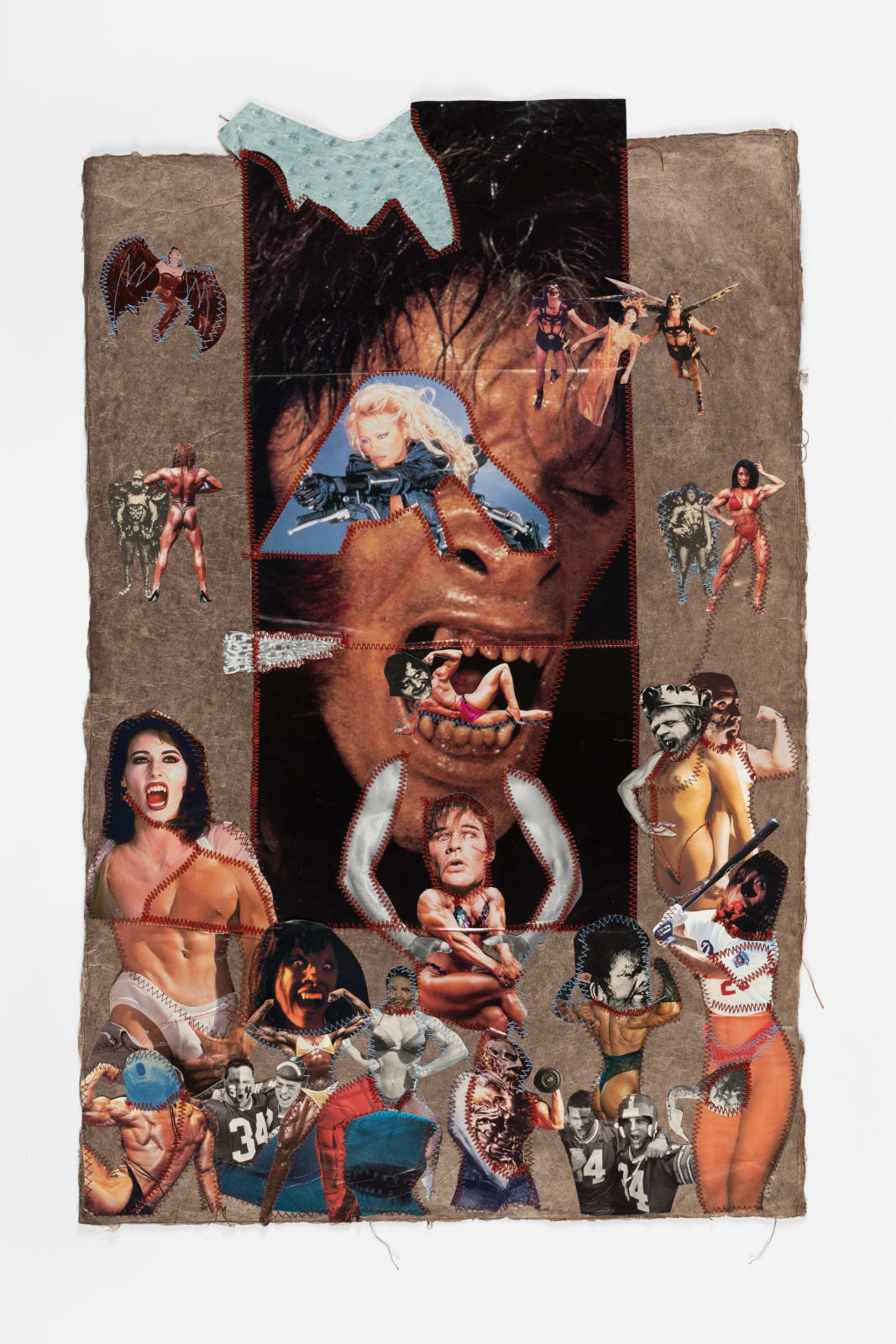
Gray Wielebinski
Hellmouth, 2021
Printed paper, leather, and cotton thread on paper
79.4 x 50.9 cm
31 1/4 x 20 1/8 in
31 1/4 x 20 1/8 in
Gray Wielebinski (b. 1991 Dallas, TX, USA) received a BA from Pomona College, Claremont CA, USA in 2014 before completing an MFA from the Slade School of Fine Art, London...
Gray Wielebinski (b. 1991 Dallas, TX, USA) received a BA from Pomona College, Claremont CA, USA in 2014 before completing an MFA from the Slade School of Fine Art, London in 2018. They live and work in both London, UK and Los Angeles, CA, USA.
Through their expansive practice, Wielebinski explores the intersections of mythology, identity, gender, nationhood, memory and sports. Reconfiguring and transforming iconography and visual codes, their work seeks to navigate and question society’s frameworks and belief systems. Wielebinski deftly confronts realities in order to imagine and propose alternatives.
Mythology weaves a strong thread throughout Wiebelinski’s works, they draw on both ancient and contemporary myths that exist in our daily lives. Their interest in myth making stemmed from an upbringing in Texas, which Wielebinski notes has a potent mythologizing of itself and a specific history and culture then moving to Los Angeles which has its own relationship to fantasy and myth making via Hollywood. Their experience of living in these places created a deep interest in storytelling. Wielebinski states ‘myths past and present can tell us a lot about power and who is able to craft and retell narratives. So, I think it’s supremely relevant and necessary to revisit and interrogate them and make our own.’
Collage is an essential mode of making for Wielebinski, for in its hybridity there is a sense of becoming – they are drawn to its potential power to subvert or create context or meanings, often from what already exists. The process of collaging runs through their practice in many forms – there is a constant layering of imagery, materiality and concept, to create works in textile, sculpture and on paper. An avid collector, Wielebinski’s source material comes from their vast archive which has developed from a childhood of collecting baseball cards.
In recent collages, Wielebinski puts together new forms and ways of embodiment, questioning what makes a body more than the sum of its parts. They dissect figures directly challenging our obsession with ‘reading’ bodies – in their intuitive combination of body parts, they make new creatures. They combine symbolically masculine and Americana imagery with classical antiquity to form dichotomous heroic and monstrous figures Partially obscured by textiles and sewn decorative elements Wielebinski references craft and traditionally feminine modes of making. Wielebinski creates a world that rejects the duality of feminine and masculine, before and after, for an inclusive utopia where multiple identities can exist.
Through their expansive practice, Wielebinski explores the intersections of mythology, identity, gender, nationhood, memory and sports. Reconfiguring and transforming iconography and visual codes, their work seeks to navigate and question society’s frameworks and belief systems. Wielebinski deftly confronts realities in order to imagine and propose alternatives.
Mythology weaves a strong thread throughout Wiebelinski’s works, they draw on both ancient and contemporary myths that exist in our daily lives. Their interest in myth making stemmed from an upbringing in Texas, which Wielebinski notes has a potent mythologizing of itself and a specific history and culture then moving to Los Angeles which has its own relationship to fantasy and myth making via Hollywood. Their experience of living in these places created a deep interest in storytelling. Wielebinski states ‘myths past and present can tell us a lot about power and who is able to craft and retell narratives. So, I think it’s supremely relevant and necessary to revisit and interrogate them and make our own.’
Collage is an essential mode of making for Wielebinski, for in its hybridity there is a sense of becoming – they are drawn to its potential power to subvert or create context or meanings, often from what already exists. The process of collaging runs through their practice in many forms – there is a constant layering of imagery, materiality and concept, to create works in textile, sculpture and on paper. An avid collector, Wielebinski’s source material comes from their vast archive which has developed from a childhood of collecting baseball cards.
In recent collages, Wielebinski puts together new forms and ways of embodiment, questioning what makes a body more than the sum of its parts. They dissect figures directly challenging our obsession with ‘reading’ bodies – in their intuitive combination of body parts, they make new creatures. They combine symbolically masculine and Americana imagery with classical antiquity to form dichotomous heroic and monstrous figures Partially obscured by textiles and sewn decorative elements Wielebinski references craft and traditionally feminine modes of making. Wielebinski creates a world that rejects the duality of feminine and masculine, before and after, for an inclusive utopia where multiple identities can exist.